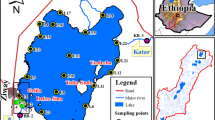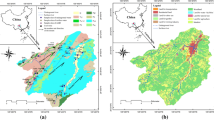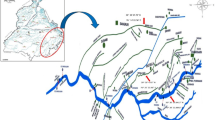Abstract
Large scale phosphate mining in the Huangbaihe River Basin, China has reduced the self-purification capacity of the basin’s fresh water. Three years (2014–2016) of monitoring data and chemometric analysis were used to identify the dominant pollutants and define their spatial distribution in the basin. Principal component analysis was applied to determine the contribution of the individual pollutants. Total phosphorus (TP) 53%, water temperature (TEMP) 27%, and total nitrogen (TN) 20% proved to be the dominant problems. A discriminant functions (DF) model was developed to classify the study area into high, moderate, and low pollution zones. The DF coefficients were applied to analyze the correlation between DF and the measured parameters and it was found that TP, TN, and TEMP were positively correlated with the DF, indicating that these parameters were the most important. Finally, the results were compared with the locations of the mining activities, which revealed that TP is higher in the upper sub-basins, Xuanmiaoguan and Tianfumiao, where most of the high pollution zones are located and more than 78% of the areas are affected by the phosphate mines. It is concluded that the phosphate mining is the major source of pollution and TP is the dominant pollutant responsible for the total water quality variation in the river basin. More effective management measures have to be taken to reduce phosphorus runoff into the reservoir watersheds.
Zusammenfassung
Großmaßstäblicher Phosphatbergbau im Huangbaihe Becken, China hat zur Herabsetzung des Selbstreinigungsvermögens des Frischwassers im Flusseinzugsgebiet geführt. Zur Identifizierung der Hauptschadstoffe und deren räumlicher Verteilung im Flussgebiet wurde eine dreijährige Zeitreihe (2014-2016) von Monitoringdaten in Kombination mit einer chemometrischen Analyse herangezogen. Mittels Hauptkomponentenanalyse wurde der Beitrag einzelner Schadstoffe bestimmt. Als vorherrschende Probleme erwiesen sich Gesamtphosphor (TP, 53%), Wassertemperatur (TEMP, 27%) und Gesamtstickstoff (TN, 20%). Zwecks Unterteilung des Untersuchungsgebiets in Zonen mit starker, mäßiger und geringer Kontamination wurde ein Diskriminanzfunktions-(DF-)modell entwickelt. Der DF-Koeffizient wurde zur Untersuchung des Zusammenhangs von DF und den Messparametern verwendet, und es zeigte sich, dass TP, TN und TEMP positiv mit DF korreliert waren und diese Parameter somit als die dominierenden angesehen werden können. Schließlich wurden die Ergebnisse mit der Lage der Bergbaustandorte abgeglichen, wobei sich zeigte, dass TP die höchsten Werte in den oberen Teileinzugsgebieten Xuanmiaoguan und Tianfumiao aufwies, wo sich auch die Zonen starker Belastung und mehr als 78 % der von Phosphatbergbau betroffenen Flächen befinden. Es wird geschlussfolgert, dass der Phosphatbergbau der hauptsächliche Kontaminationsverursacher ist und dass TP der für die Schwankung der Wassergüte im Flussgebiet wichtigste Schadstoff ist. Effektivere Steuerungsmaßnahmen sind nötig zur Verringerung des Phosphoreintrags in die Gewässer.
Resumen
La minería de extracción de fosfato a gran escala en la cuenca del río Huangbaihe, China, ha reducido la capacidad de autolimpieza del agua dulce de la cuenca. Se monitoreó durante tres años (2014-2016) los datos y análisis quimiométricos para identificar los contaminantes predominantes y definir su distribución espacial en la cuenca. El análisis de componentes principales se aplicó para determinar la contribución de los contaminantes individuales. El fósforo total (TP) 53%, la temperatura del agua (TEMP) 27% y el nitrógeno total (TN) 20% resultaron ser los problemas más importantes. Se desarrolló un modelo de funciones discriminantes (FD) para clasificar el área de estudio en zonas de alta, moderada y baja contaminación. Los coeficientes del DF se aplicaron para analizar la correlación entre el DF y los parámetros medidos y se encontró que TP, TN y TEMP correlacionaron positivamente con el DF, lo que indica que estos parámetros eran efectivamente los más importantes. Finalmente, los resultados se compararon con la ubicación de las actividades mineras, que revelaron que el TP es mayor en las subcuencas superiores, Xuanmiaoguan y Tianfumiao, donde se localizan la mayoría de las zonas de alta contaminación y más del 78% de las áreas afectadas por las minas de fosfato. Se concluye que la extracción de fosfato es la principal fuente de contaminación y TP es el contaminante predominante responsable de la variación total de la calidad del agua en la cuenca del río. Se deben tomar medidas de manejo más efectivas para reducir la escorrentía de fósforo en las cuencas hidrográficas del embalse.
摘要
黄柏河流域(中国)大规模磷矿开采已经减弱流域淡水的自净能力。利用三年监测数据(2014-2016)及化学计量学方法识别水体主要污染物和分析污染物空间分布。应用主成分分析法确定单一污染物的贡献率,主要污染问题表现为总磷(TP)53%、水温(TEMP) 27%和总氮(TN)20%。建立了判别函数(DF)模型并将研究区分为高、中和低污染区。判别函数系数反映判别公式(DF)与测量参数之间的关系,发现总磷(TP)、总氮(TN)和水温(TEMP)与判别函数(DF)呈正相关,说明这些参数对判别至关重要。最后,通过与采矿活动地点对比,发现玄庙观、天福庙等上游水体总磷(TP)更高,上游集中了多数高污染区且78%以上范围都为磷矿开采所影响。由本研究可以看出,磷矿开采为主要污染源,总磷(TP)是流域水质变化的主要污染物。建议采取更有效的管理措施减少含磷径流汇入各下游水库。



Similar content being viewed by others
References
Aguilera PA, Castro H, Rescia A, Schmitz MF (2001) Methodological development of an index of coastal water quality: application in a tourist area. Environ Manag 27:295–301
Association IFI (2001) Environmental aspects of phosphate and potash mining. UNEP, Paris
Bao Y, Wang Y, Hu M, Wang Q (2018) Phosphorus fractions and its summer flux from sediments of deep reservoirs located at a phosphate-rock watershed, Central China. Water Sci Technol 18:688–697
Boyacioglu H (2007) Surface water quality assessment by environmetric methods. Environ Monit Assess 131:371–376
Brereton RG (2003) Chemometrics: data analysis for the laboratory and chemical plant. Wiley, Chichester
China E (2002) Environmental quality standards for surface water (GB3838-2002). MEP, Beijing
Chraiti R, Raddaoui M, Hafiane A (2016) Effluent water quality at phosphate mines in M’Dhilla, Tunisia and its potential environmental effects. Mine Water Environ 35:462–468
Das B (1999) Environmental pollution of Udaisagar lake and impact of phosphate mine, Udaipur, Rajasthan, India. Environ Geol 38:244–248
Dixon W, Chiswell B (1996) Review of aquatic monitoring program design. Water Res 30:1935–1948
Fakayode SO (2005) Impact of industrial effluents on water quality of the receiving Alaro River in Ibadan, Nigeria. Afr J Environ Assess Manag 10:1–13
Fisher RA (1936) The use of multiple measurements in taxonomic problems. Ann Eugen 7:179–188
Gazzaz NM, Yusoff MK, Ramli MF, Aris AZ, Juahir H (2012) Characterization of spatial patterns in river water quality using chemometric pattern recognition techniques. Mar Pollut Bull 64:688–698
Gu Q et al (2016) Assessment of reservoir water quality using multivariate statistical techniques: a case study of Qiandao Lake, China. Sustain Basel 8:243
Helena B, Pardo R, Vega M, Barrado E, Fernandez JM, Fernandez L (2000) Temporal evolution of groundwater composition in an alluvial aquifer (Pisuerga River, Spain) by principal component analysis. Water Res 34:807–816
Horel JD (1981) A rotated principal component analysis of the interannual variability of the Northern Hemisphere 500 mb height field. Mon Weather Rev 109:2080–2092
Jiries A, El-Hasan T, Al-Hweiti M, Seiler K-P (2004) Evaluation of the effluent water quality produced at phosphate mines in central Jordan. Mine Water Environ 23:133–137
Kaiser HF (1960) The application of electronic computers to factor analysis. Educ Psychol Meas 20:141–151
Kannel PR, Lee S, Kanel SR, Khan SP (2007) Chemometric application in classification and assessment of monitoring locations of an urban river system. Anal Chim Acta 582:390–399
Kothai P, Saradhi I, Prathibha P, Hopke PK, Pandit G, Puranik V (2008) Source apportionment of coarse and fine particulate matter at Navi Mumbai, India. Aerosol Air Qual Res 8:423–436
Kowalkowski T, Zbytniewski R, Szpejna J, Buszewski B (2006) Application of chemometrics in river water classification. Water Res 40:744–752
Lewelling B, Wylie R (1993) Hydrology and water quality of unmined and reclaimed basins in phosphate-mining areas, west-central Florida. Water Resour Investig Rep 93:4002
Lopes FB, Andrade EM, Meireles A, Becker H, Batista AA (2014) Assessment of the water quality in a large reservoir in semiarid region of Brazil. Rev Bras Eng Agr Amb 18:437–445
Nalini A, Mohamed AF, Chiew EF, Mohamed Z (2010) Supply chain analysis of fresh fruits and vegetables (FFV): prospects of contract farming. Agric Econ 56:435–442
Norušis MJ (1986) SPSS/PC+ for the IBM PC/XT/AT, vol 1. SPSS, Chicago
Papaioannou A, Dovriki E, Rigas N, Plageras P, Rigas I, Kokkora M, Papastergiou P (2010) Assessment and modelling of groundwater quality data by environmetric methods in the context of public health. Water Resour Manag 24:3257–3278
Paul S, Srinivasan R, Sanabria J, Haan PK, Mukhtar S, Neimann K (2006) Groupwise modeling study of bacterially impaired watersheds in Texas: clustering analysis 1. J Am Water Resour Assoc 42:1017–1031
Qu J, Meng X, Ye X, You H (2016) Characteristic variation and original analysis of emergent water source pollution accidents in China between 1985 and 2013. Environ Sci Pollut Res 23:19675–19685
Quirós R (2003) The relationship between nitrate and ammonia concentrations in the pelagic zone of lakes. Limnetica 22:37–50
Simeonov V, Stefanov S, Tsakovski S (2000) Environmetrical treatment of water quality survey data from Yantra River, Bulgaria. Microchim Acta 134:15–21
Singh KP, Malik A, Sinha S (2005) Water quality assessment and apportionment of pollution sources of Gomti river (India) using multivariate statistical techniques—a case study. Anal Chim Acta 538:355–374
Tinsley HE, Brown SD (2000) Handbook of applied multivariate statistics and mathematical modeling. Academic Press, New York
Uyanik A, Tinkiliç N, Odabaşoğlu M, Karaca H (1999) Spectrophotometric determination of uranium in waste water of phosphoric acid and fertilizer manufacturing process. Turk J Chem 23:275–284
Vega M, Pardo R, Barrado E, Debán L (1998) Assessment of seasonal and polluting effects on the quality of river water by exploratory data analysis. Water Res 32:3581–3592
Wang K, Lin Z, Zhang R (2016) Impact of phosphate mining and separation of mined materials on the hydrology and water environment of the Huangbai River basin, China. Sci Total Environ 543:347–356
Ward JH Jr (1963) Hierarchical grouping to optimize an objective function. J Am Stat Assoc 58:236–244
Xiangcan J (2003) Analysis of eutrophication state and trend for lakes in China. J Limnol 62:60–66
Yang W-Q, Xiao H, Li Y, Miao D-R (2018) Vertical distribution and release characteristics of phosphorus forms in the sediments from the river inflow area of Dianchi Lake, China. Chem Speciat Bioavailab 30:14–22
Zhu X, Li D, He D, Wang J, Ma D, Li F (2010) A remote wireless system for water quality online monitoring in intensive fish culture. Comput Electron Agric 71:S3–S9
Acknowledgements
This research has been supported by the Non-profit Industry Financial Program of Ministry of Water Resources of China (no. 201301066), the National Natural Science Foundation of China (40701024, 41101511, 51409152), and Hubei Provincial Collaborative Innovation Center for Water Security.
Author information
Authors and Affiliations
Corresponding author
Rights and permissions
About this article
Cite this article
Reta, G.L., Dong, X., Su, B. et al. The Influence of Large Scale Phosphate Mining on the Water Quality of the Huangbaihe River Basin in China: Dominant Pollutants and Spatial Distributions. Mine Water Environ 38, 366–377 (2019). https://doi.org/10.1007/s10230-019-00604-6
Received:
Accepted:
Published:
Issue Date:
DOI: https://doi.org/10.1007/s10230-019-00604-6




